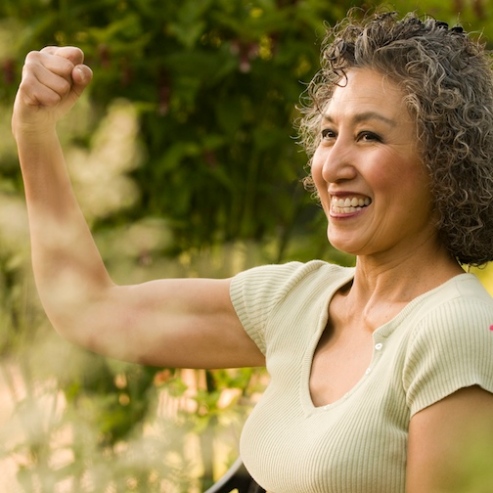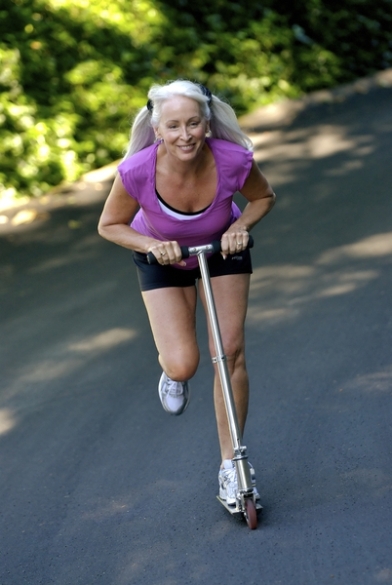When was the last time you thought about your personal risk for breast cancer? Hopefully it’s been on your mind somewhat during this autumnal month of National Breast Cancer Awareness. But let not the disappearance of pink ribbons as October wanes, rob us of the greater message of our hard won awareness. That despite all the money raised and billions spent, we still have no guaranteed treatment for breast cancer. In the meantime, let’s face it, continuing the war on cancer with the latest designer drugs or procedures is big business. Sometimes it works and we survive to race for the cure. But breast cancer keeps catching up, and overtaking too many of us. One in eight women; the numbers have not budged. In North America a woman dies of breast cancer every 12 minutes. Still no cure. Except to prevent it in the first place. I don’t mean to sound glib, but I have science on my side here. Prevention is Doable.
Not every breast cancer is inherited. In fact, the majority manifest as the end result of risks we knowingly or unknowingly take with our health every day – the overworked, overfed, overstressed, toxic lifestyle, that over time is a breast cancer waiting to happen. Many of us are living this way. Many of us are at risk. So. What do we do about it? Is it too late to reduce our odds to slim and none? Can we do something, right now?
Yes. Absolutely. You can start by losing weight and balancing your hormones.
As it turns out, these may be two of the most important actions we can take to reduce breast cancer in our lifetime. The evidence is there, and growing. Numerous studies in the medical literature report the association between out of balance hormones and lifestyle to cancers.
For example, a recent study published in Cancer, a peer-reviewed journal of the American Cancer Society (Dec 2012, vol. 118), found that extra pounds—even within the overweight but not obese range—are linked to a 30 percent higher risk of breast cancer recurrence and a nearly 50 percent higher risk of death despite optimal treatment. Given that the most common type of breast tumors are fueled by excess estrogen, and that fat cells (via aromatase conversion) are mini-estrogen producing factories, pinpointing the hormonal links to weight gain is a key to preventing breast cancers.
Dr. John Lee, M.D. and David Zava, Ph.D. are at pains to make that very point in their groundbreaking book, What Your Doctor May Not Tell You About Breast Cancer: How Hormone Balance Can Help Save Your Life. “Experts agree that environmental risk factors, such as diet and exposure to toxins, account for about 80% of breast cancers, and genetic factors account for about 20 percent. Even those who happen to have a genetic predisposition can improve their chances of dodging a breast cancer diagnosis with hormone balance and a healthy diet.”
So what are the best ways to dodge a breast cancer diagnosis in the first place? To RAZE (as in demolish) your personal risk for breast cancer it is GOOD to Do These Things:
- First test your hormone levels to detect hidden imbalances. Examples such as estrogen dominance or high cortisol stress hormones are associated with weight gain, as well as higher risks for breast cancer.
In case you haven’t heard, ZRT Laboratory just launched a Weight Management Profile that can detect and help correct such imbalances.
- If estrogen dominance is identified through testing, take steps to correct it ASAP. An estimated 97% of breast cancers are linked with excess estrogens unbalanced by adequate progesterone.
- Fill up on high fiber, cruciferous vegetables like cabbage, broccoli, cauliflower and Brussels sprouts that help promote proper estrogen metabolism.
- Get your “good fats” in avocados, olive/coconut oils, nuts and seeds to help inhibit tumor growth, boost immunities, and reduce inflammation.
- A daily dose of 64 oz. of water can flush out free radicals and toxins that invite cancers.
- Avoid bad “xeno” hormones with hormone-free meat/dairy/poultry. Also make sure to microwave in glass or ceramic vs. plastic containers, drink from non-plastic water bottles, and choose “green” household, garden and personal care products.
- Minimize stress to stabilize cortisol, blood sugars and insulin levels. When those levels are elevated, they provide raw fuel for tumors. Prioritizing time to de-stress, eat right, get enough sleep, and exercise are HUGE when it comes to boosting your immune reserves against cancer.
So there you have it! Seven lifesaving steps to balancing your hormones which in turn will reduce your own personal risks for breast cancer, which in turn will help to prevent it ever happening in the first place, to you or to anyone else, which in turn will eventually put an end to this dread disease we don’t deserve.
What we do deserve is for the National Cancer Institute (NCI) and the National Institutes of Health (NIH) and all the other prestigious scientific bodies out there to prioritize prevention. (Note: NCI still spends the majority of its entire budget on treatments and diddlysquat on research into prevention.) Time to take the pink earbuds out and turn all that awareness into action.
 Here’s another blog that gives you more information on hormone balancing. Just click on the link: http://menopausibilities.com/2012/05/23/you-could-be-walking-around-with-a-hormone-imbalance-and-not-even-know-it-oprah-said-that-but-what-did-she-mean-hormone-imbalance-defined/
Here’s another blog that gives you more information on hormone balancing. Just click on the link: http://menopausibilities.com/2012/05/23/you-could-be-walking-around-with-a-hormone-imbalance-and-not-even-know-it-oprah-said-that-but-what-did-she-mean-hormone-imbalance-defined/



































